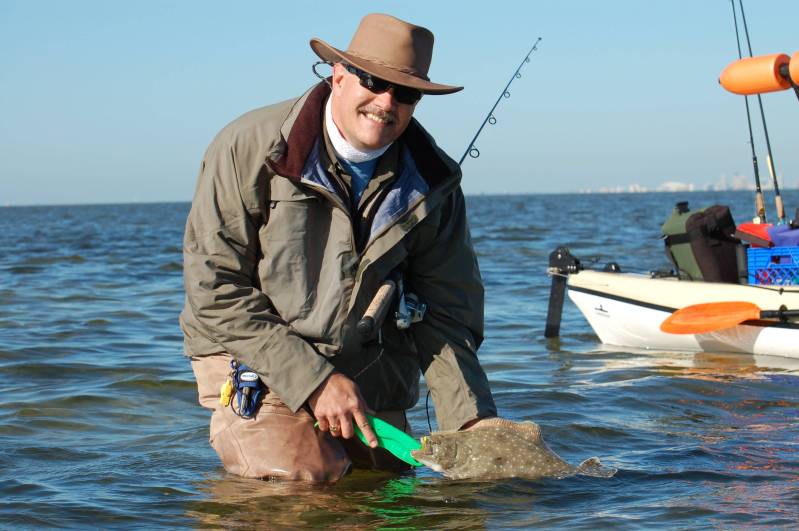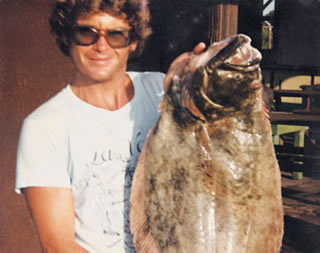May 16, 2011
By Florida Sportsman

Can Florida's flounder stocks stand up to unlimited commercial fishing and loose laws?
It's heartbreaking to listen to an old salt lament over diminishing numbers and poor catches of flounders lately.
There is growing concern among hook-and-line fishers, especially, over a decimation of flounder stocks by commercial giggers and divers who target flounder for bucks. Unfortunately, large brood-stock females bring the top dollars.
It seems obvious that tighter restrictions are needed for both commercial and recreational sectors. State records indicate an approximate 40 percent drop in pounds of flounder caught between 1993 and 2002. Total catch, recreational and commercial, for 1993 was close to one million pounds, compared to a little less than 600,000 pounds in 2002.

Flounder could be the cash crop of the future for fish farmers. |
Three flounder species—gulf, southern and summer—grace Florida waters. Their delicate taste makes them a highly sought table fish and they command a price comparable to grouper. It's no surprise that growing numbers of market fishermen have set sights on flatfish. What is a surprise to many is that restrictions are few. Commercial giggers must possess a SPL (Salt Water Products License) with a RS (Restricted Species) endorsement. There is a 12-inch minimum size limit, same as applies to recreational catches.
That's where the similarities end. In Florida, recreational anglers may take a limit of 10 fish. Not so for commercials, who can gig, spear, cast net, beach or haul seine and hook and line as many flatties over 12 inches long as they can put in the box. Netters are allowed 50 pounds per person as incidental “bycatch” per Florida rules. Bycatch in this case refers to flounder taken while fishing with any gear other than that allowed while targeting a species other than flounder for which the use of such gear is allowed. Nine times out of ten this means shrimp trawls.
Many old-time recreational flounder fishermen have expressed disgust over the disparity in regulations, saying that flounder numbers have plunged in recent years, especially on Florida's upper and central east coasts where more and more commercials are jumping on the flounder money train.
Venture to Matanzas, St. Augustine, Ponce or Fort George inlets. On good nights, you'll see as many as 25 boats running the shorelines gigging every flounder larger than 12 inches in sight. Multiply that number by 365 nights and remove any trip limit or quota and it's easy to see that Florida flatfish face trouble. Both species, southern flounder and gulf flounder, are nightly targets of giggers and daytime targets for commercial divers who hunt for them around nearshore and offshore wrecks where they stack up during spawning season.
“Law shouldn't allow any flounder to be sold that has holes in it,” a Matanzas Inlet regular said. That's a powerful statement coming from a 20-year Northeast Florida flounder vet, who until 2002, caught a flounder or two practically every day he tossed out a line.
Florida fishery managers claim that recreational fishermen account for the majority of this state's flounder catches, a figure many hook-and-line recreational flounder vets dispute. Of course, it should be expected that non-commercials would take a lion's share collectively since they outnumber the market takers by 100 to 1 or more in most fisheries. On a per-person basis, commercial fishermen are allowed to take a far, far greater number than the family-level anglers.
A report by Mike Murphy at Florida Marine Research Institute found, “that adequate information was not available to assess the condition of southern or gulf flounder stocks in Florida.” That's alarming. The state has a flounder-accounting problem. It makes no sense that Florida allows unlimited commercial catches of flounder when the state has no idea how many fish are being landed nor what the actual status of the stocks is. Recreational landings are determined primarily by the feds' random telephone survey, combining total trips times reported catch figures.

Doormat flounder, like this 16-pounder caught in the early '80s, are becoming a rare catch. |
Florida anglers I interviewed shared one concern: Flounder fishing isn't what it used to be. Remarks like this came from folks in St. Augustine, Sebastian, Wabasso, Sarasota and the Panhandle. Many concluded that, nowadays, returns seldom seem worth the effort.
Stock Rebuilding Strategies
Many anglers agree that several key changes could help rebuild flounder stocks—reducing bag limits for recreational fishermen, while establishing limits for commercials and increasing the minimum size limit across the board.
Ken Riley, director of aquaculture education at Harbor Branch Oceanographic Institution in Fort Pierce, shed some light on upping the minimum size.
“Southern flounder begin to spawn at two years of age, but really don't start contributing to stock renewal of the fishery until age three,” Riley explained while giving me a tour of Harbor Branch's aquaculture facilities. “A 3-year-old fish might produce 100,000 eggs over a year. A 10-year-old flounder produces over half a million eggs at one time.”
It's no wonder that targeting larger females for the commercial market has a detrimental effect on flounder stocks. Most recreational anglers expressed support for changes in size and bag limits, according to survey results on the Florida Sportsman Online Fishing Forum. Many say lowering the bag to five fish per day would not affect them in the least, because they rarely catch 10 flounder per day. Upping the minimum size from 12 to 15 inches would also allow flounder to mature and spawn, which should help replenish dwindling stocks.
Another approach would be to close prime flounder spawning months, November through January, to commercial harvest. According to Riley, flounder must spawn in salt water to float the eggs. Mass exodus to offshore spawning sites is water temperature influenced. Readings in the low 60s trigger the move offshore with 61 degrees considered the “magic” number. After they spawn, flounder head back inshore.
Protecting flounder from large-scale catches during this critical time seems like a logical solution for rebuilding stocks.
Bycatch, Bykill
Flounder also have an unnatural enemy that decimates their ranks—shrimp and bottom trawls. It used to be standard practice for shrimpers returning into an inlet to drag the nets and scoop flatties off the bottom—particularly in the fall when dropping water temperature has flounder flocking to the inlets. The glut of small flounder swept up in the nets often sent wholesale and retail prices spiraling downward.
Texas fishery managers realized flounder stocks could not stand up to the continued pilfering of juvenile fish. Pat Murray, executive director of CCA Texas said, “It became clear that discards of juveniles as shrimp bycatch was the biggest drain on flounder populations. Since the state began requiring shrimpers to use bycatch reduction devices (BRDs), we have seen an upward trend in numbers.”
Texas fishery managers have instituted a program—funded by a $3 surcharge on recreational fishing license fees—to buy back shrimping permits because of the detrimental consequences that inshore, bay trawling has on flounder stocks.
Texas Director of Coastal Fisheries Larry McKinney recognizes flounder as a species of special concern. “Since 1977, we've seen a steady decline in flounder numbers. That leveled out in the late '90s with better rules. But, inshore bay shrimping still has a tremendous negative impact. Although we've reduced shrimp bycatch by 20 to 50 percent, we still lose about a million fish a year to bykill. Texas fishermen have generated over $7 million in bay shrimping buy-back funds, reducing the number of inshore bait and food shrimping permits by 1,258 or 38 percent.” McKinney and other Texas fishery managers hope the plan will replenish flounder stocks noticeably, before the state has to begin raising the fish in hatcheries for restocking purposes.
Texas also limits commercial catches. Bag is 60 fish with a minimum 14-inch size limit. Recreational anglers are allowed 10 fish above 14 inches. Rules vary greatly from state to state, but Texas regs are stricter than most.
Old-time Apalachicola shrimpers voluntarily kept their nets up while traversing this North Florida bay. FS Field Editor Rick Farren recalls an article that quoted George Kirvin, a pioneer of the Apalachicola Bay shrimp fishery. He said, “Back in the '40s nobody shrimped in Apalachicola Bay. Flounder were a mainstay of the local fishing industry. We needed them in summer when the shrimp didn't run.”
It seems certain that expanded flounder farming (see sidebar), combined with tighter laws regulating both commercial and recreational takings would bring back “doormat” flounders to old-days abundance, providing maximum benefits for the most citizens.
FS

